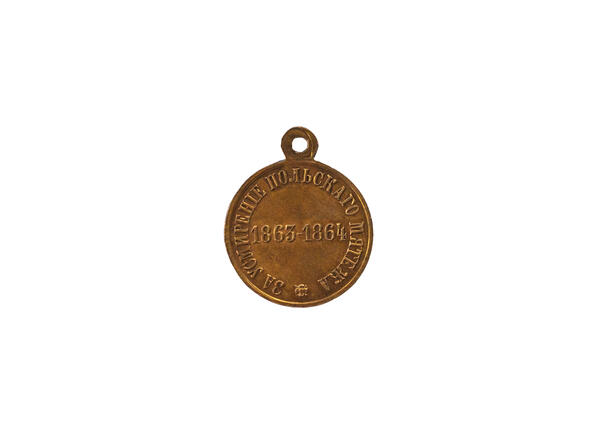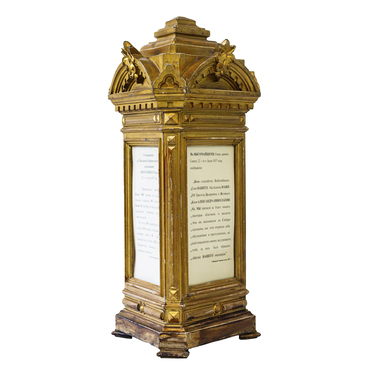Medal, which was awarded to the participants of the suppression of the uprising of 1863–1864 in the Kingdom of Poland, North-Western region, and Volyn, was established in 1865.
There were two versions of the medal made: light and dark bronze. The exhibition includes a light-bronze version. About 370,000 of these medals were minted at the Saint Petersburg Mint.
On the obverse is the national coat of arms of the Russian Empire: a double-headed eagle crowned with the imperial crown, holding a scepter and an orb. The inscription on the back is embossed: “For the Suppression of the Polish Uprising, ” and dates: “1863–1864”.
After the country’s third division, the Rzeczpospolita (The Polish-Lithuanian Commonwealth) ceased to exist as an independent state. Its lands were divided between Russia, Prussia, and Austria. In 1815, Polish territories within the Russian Empire were declared the Kingdom of Poland, received a constitution and considerable self-government. However, in November 1830, a national uprising began, which Nicholas I managed to suppress in 1831. After that, the Emperor abolished the Polish constitution.
Subsequently, the Russian government pursued a policy of suppressing national and religious patriotism, but at the same time restored some elements of the autonomy of the Kingdom of Poland. In 1861–1862, Emperor Alexander II established a local State Council, elected provincial and district councils, but these transformations did not bring any significant results.
On January 10, 1863, in the Kingdom of Poland, North-West region, and in Volyn a rebellion began. Its aim was the restoration of the Polish-Lithuanian Commonwealth within the borders of 1772. The event that started the riots was the recruitment, which on the night of January 3 was held not by drawing lots, but according to lists drawn up in advance. On the night of January 11, insurgents attacked Russian garrisons. The main participants in the rebellion were the szlachta (Polish gentry), the townspeople, and the Catholic clergy.
The revolt ended with the defeat of the rebels in June 1864. On this occasion, Emperor Alexander II, by the highest decree as of January 1, 1865, established a medal for rewarding all the participants of the rebellion suppression. Medals of light bronze were awarded to soldiers who participated in hostilities, medics, auditors, military priests, and officials who participated in the fighting or were in the troops.
There were two versions of the medal made: light and dark bronze. The exhibition includes a light-bronze version. About 370,000 of these medals were minted at the Saint Petersburg Mint.
On the obverse is the national coat of arms of the Russian Empire: a double-headed eagle crowned with the imperial crown, holding a scepter and an orb. The inscription on the back is embossed: “For the Suppression of the Polish Uprising, ” and dates: “1863–1864”.
After the country’s third division, the Rzeczpospolita (The Polish-Lithuanian Commonwealth) ceased to exist as an independent state. Its lands were divided between Russia, Prussia, and Austria. In 1815, Polish territories within the Russian Empire were declared the Kingdom of Poland, received a constitution and considerable self-government. However, in November 1830, a national uprising began, which Nicholas I managed to suppress in 1831. After that, the Emperor abolished the Polish constitution.
Subsequently, the Russian government pursued a policy of suppressing national and religious patriotism, but at the same time restored some elements of the autonomy of the Kingdom of Poland. In 1861–1862, Emperor Alexander II established a local State Council, elected provincial and district councils, but these transformations did not bring any significant results.
On January 10, 1863, in the Kingdom of Poland, North-West region, and in Volyn a rebellion began. Its aim was the restoration of the Polish-Lithuanian Commonwealth within the borders of 1772. The event that started the riots was the recruitment, which on the night of January 3 was held not by drawing lots, but according to lists drawn up in advance. On the night of January 11, insurgents attacked Russian garrisons. The main participants in the rebellion were the szlachta (Polish gentry), the townspeople, and the Catholic clergy.
The revolt ended with the defeat of the rebels in June 1864. On this occasion, Emperor Alexander II, by the highest decree as of January 1, 1865, established a medal for rewarding all the participants of the rebellion suppression. Medals of light bronze were awarded to soldiers who participated in hostilities, medics, auditors, military priests, and officials who participated in the fighting or were in the troops.


